Mostrar el registro sencillo del ítem
dc.contributor.author
Bryk, Gabriel

dc.contributor.author
Zeni Coronel, Estefania Magali

dc.contributor.author
Lugones, Carlos Alejandro

dc.contributor.author
Mandalunis, Patricia Mónica

dc.contributor.author
Rio, Maria Esther

dc.contributor.author
Gualtieri, Ariel Félix

dc.contributor.author
Pita Martín de Portela, María Luz

dc.contributor.author
Zeni, Susana Noemi

dc.date.available
2018-06-21T20:08:19Z
dc.date.issued
2016-12
dc.identifier.citation
Bryk, Gabriel; Zeni Coronel, Estefania Magali; Lugones, Carlos Alejandro; Mandalunis, Patricia Mónica; Rio, Maria Esther; et al.; Effect of a mixture of GOS/FOS® on calcium absorption and retention during recovery from protein malnutrition: experimental model in growing rats; Dr. Dietrich Steinkopff Verlag; European Journal of Nutrition; 55; 8; 12-2016; 2445-2458
dc.identifier.issn
1436-6207
dc.identifier.uri
http://hdl.handle.net/11336/49594
dc.description.abstract
Introduction: During growth, protein deprivation impairs epiphyseal growth plate (EGP) height, bone volume (BV) and endochondral ossification. During catch-up growth, Ca availability becomes essential to ensure the extra amount needed to achieve optimal peak bone mass and strength. GOS and FOS improve mineral absorption in the colon. Purpose: The effect of a mixture of GOS/FOS® 9:1 added to a 0.5 %Ca (NCa) and a 0.3 %Ca (LCa) diets on Ca, P and Mg absorptions and bone mineralization, density and structure using an experimental model of growing rats recovering from early protein malnutrition was investigated. Methods: To induce protein malnutrition, rats were fed a low protein diet: 4 % (LPD) during 1 week and then were randomly assigned to recovery groups (R) until day 50 (T = 50) as follows: R0.5 %: NCa; RP0.5 %: NCa + 5.3 % GOS/FOS®; R0.3 %: LCa and RP0.3 %: LCa + 5.3 % GOS/FOS®. Control groups received the 0.5 %Ca or 0.3 %Ca diet from weaning until day 40 or 50. Results: Body weight and length increased in C groups throughout the study; both were arrested in all R during LPD consumption and increased immediately after re-feeding. Independently of dietary Ca content, LS counts, β-glucosidase and Ca, P and Mg absorption increased, whereas cecum pH, β-glucuronidase, urease and tryptophanase decreased in RP0.5 %: and RP0.3 %: as compared to the other studied groups (p < 0.01). Prebiotic consumption decreased CTX levels and increased femur Ca, Mg and P contents, total skeleton bone mineral content, proximal tibia and spine BMD, BV, EGP height and hypertrophic zone thickness, stiffness and elastic modulus as compared to recovery groups fed the prebiotic-free diets. Conclusion: Under the present experimental conditions, GOS/FOS® mixture induced colonic positive effects, which increased Ca, P and Mg absorption. Thus, consuming the prebiotic-containing diet resulted in an extra amount of minerals that improved bone development in growing rats recovering from protein malnutrition.
dc.format
application/pdf
dc.language.iso
eng
dc.publisher
Dr. Dietrich Steinkopff Verlag

dc.rights
info:eu-repo/semantics/openAccess
dc.rights.uri
https://creativecommons.org/licenses/by-nc-sa/2.5/ar/
dc.subject
Calcium Absorption
dc.subject
Calcium Retention
dc.subject
Catch-Up Growth
dc.subject
Fructo-Oligosaccharides
dc.subject
Galacto-Oligosaccharides
dc.subject
Undernourished Rats
dc.subject.classification
Otras Medicina Básica

dc.subject.classification
Medicina Básica

dc.subject.classification
CIENCIAS MÉDICAS Y DE LA SALUD

dc.title
Effect of a mixture of GOS/FOS® on calcium absorption and retention during recovery from protein malnutrition: experimental model in growing rats
dc.type
info:eu-repo/semantics/article
dc.type
info:ar-repo/semantics/artículo
dc.type
info:eu-repo/semantics/publishedVersion
dc.date.updated
2018-06-05T20:12:45Z
dc.identifier.eissn
1436-6215
dc.journal.volume
55
dc.journal.number
8
dc.journal.pagination
2445-2458
dc.journal.pais
Alemania

dc.journal.ciudad
Berlín
dc.description.fil
Fil: Bryk, Gabriel. Consejo Nacional de Investigaciones Científicas y Técnicas. Oficina de Coordinación Administrativa Houssay. Instituto de Inmunología, Genética y Metabolismo. Universidad de Buenos Aires. Facultad de Medicina. Instituto de Inmunología, Genética y Metabolismo; Argentina
dc.description.fil
Fil: Zeni Coronel, Estefania Magali. Consejo Nacional de Investigaciones Científicas y Técnicas. Oficina de Coordinación Administrativa Houssay. Instituto de Inmunología, Genética y Metabolismo. Universidad de Buenos Aires. Facultad de Medicina. Instituto de Inmunología, Genética y Metabolismo; Argentina
dc.description.fil
Fil: Lugones, Carlos Alejandro. Consejo Nacional de Investigaciones Científicas y Técnicas. Oficina de Coordinación Administrativa Houssay. Instituto de Inmunología, Genética y Metabolismo. Universidad de Buenos Aires. Facultad de Medicina. Instituto de Inmunología, Genética y Metabolismo; Argentina
dc.description.fil
Fil: Mandalunis, Patricia Mónica. Universidad de Buenos Aires; Argentina
dc.description.fil
Fil: Rio, Maria Esther. Consejo Nacional de Investigaciones Científicas y Técnicas; Argentina
dc.description.fil
Fil: Gualtieri, Ariel Félix. Universidad de Buenos Aires; Argentina
dc.description.fil
Fil: Pita Martín de Portela, María Luz. Universidad de Buenos Aires; Argentina
dc.description.fil
Fil: Zeni, Susana Noemi. Consejo Nacional de Investigaciones Científicas y Técnicas. Oficina de Coordinación Administrativa Houssay. Instituto de Inmunología, Genética y Metabolismo. Universidad de Buenos Aires. Facultad de Medicina. Instituto de Inmunología, Genética y Metabolismo; Argentina
dc.journal.title
European Journal of Nutrition

dc.relation.alternativeid
info:eu-repo/semantics/altIdentifier/doi/https://dx.doi.org/10.1007/s00394-015-1052-5
dc.relation.alternativeid
info:eu-repo/semantics/altIdentifier/url/https://link.springer.com/article/10.1007%2Fs00394-015-1052-5
Archivos asociados
